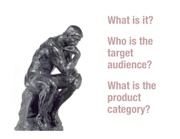
Imagine that you are a CCAD student. You are taking LA (Liberal Arts) course #341: "Marketing For Designers."
I feel your pain. I'm taking the course, too.
Actually, I'm teaching it. But taking a course and teaching it are oddly similar.
There's just a time difference, really. The teacher is a week ahead.
But You Missed The First Class?
0 for 1, huh? Dude, you're going to have to come to class more often. (May I please call you "Dude"?)
Here's what you missed. (And, if you came to class, here's some of what you heard.)
First, here are the presentation slides.
But, now, here are the key messages from the first class…
Orientation is Everything
When we face a marketing challenge, it's essential to take a deep breath and ask three questions:
- What is it? We considered the first product: a CCAD education. Funny, but most of us don't really know what it is, even when it costs $100,000 — or is it really more like $250,000, once all costs, including opportunity cost are included?
When asked, "What is a CCAD education?" our answers are at first poetic and romantic: "security," "a step toward self-sufficiency," "skills." These are all true answers, and such answers will be very useful later in the marketing process. But — at the very start of a marketing analysis — let's always pause to be more literal, more clinical, more technical.
What is it? Four years (not including vacations) of art and other classes, working with professors and alone, to develop fundamental and advanced skills in a chosen artistic pursuit. (That's not perfect language, but it gets closer to saying, specifically, what it is.
- Who is the target audience? We talked about The New Yorker, from which many of our assigned readings come. What is it? OK, it's a magazine. (It's also a website, an implied membership club, and a way of thinking. If you want to know how The New Yorker thinks, consider the brilliant and funny reporting on the recent Olympics from Anthony Lane in his first and second "Letter From Beijing." Careful; they're long. That's sometimes how The New Yorker thinks.) So, who is the target audience? We started broadly, people who can read. That's great, and essential, because it would be wasteful to invite illiterate people to subscribe.
But the creative team (who will receive our marketing strategy when its ready) will want more help than that. What is the age range of the target audience? What about other demographics: where do they live, how do they live? I mean, really: who are these people? Answering this question, we want to have both facts and poetry. Who is the target audience?
The audience for The New Yorker might be: people seeking both entertainment and information, people who go to cocktail parties (and need to be able to chat about culture), New Yorkers, former New Yorkers (who miss it), people who spend more than $1,000 each year on books, card-carrying members of any public library, registered voters, subscribers to The New York Times (but not the New York Post), people who mail handwritten thank-you notes, and so on. I might be wrong on any of these suggestions, but we have to explore the possibilities. It needs to be more specific than the broadest definition: people who read.
- What is the product category? We considered yoga. While not strictly a product, we can ask the same questions about yoga. After trying to describe what it is, we considered its product category. (What do we mean "product category?" We mean: what is the group of similar products that compete with yoga?)
At first, narrowly, we see it in the product category of mind-body exercise. In that category, we would compete with Pilates, Tai Chi, other martial arts, etc.
But we must — we owe it to the challenge before us — look more broadly at the competition. How about these other categories: ways to spend leisure time (competing with Netflix), methods for staying sane (competing with legal and illegal drugs), trendy exercises (again Pilates and Tai Chi, but also spinning and hardcore aerobics). And so on.
Only after we have considered a wide variety of possible categories of competitors can we focus on the one that makes the most sense, the one that might offer us the most potential. Which one is it? We don't know yet. We'll have to try a few with some of the marketing models that are headed our way during the coming weeks.
That concludes my formal presentation.
Any questions?
"Yes, I have a question."
Please.
"Why have you told us this? Why do we ask these three questions?"
Great question. Thanks for asking it.
I'm often surprised by the otherwise smart people who jump into a challenge downstream. They just jump in the river without looking upstream and thinking about the source of the river.
These three questions are a good way to start thoughtfully, to consider three basic aspects of the product's eventual marketing.
- What (is it)? The product
- For whom (is it offered)? The target audience.
- Against what (does it compete)? The product category.
Anyone else? Yes, you there, with the baseball cap pulled down over your eyes. I didn't know you were even awake.
"Why does this blog post read like a chapter of a marketing textbook?"
Oh, yes. I'm writing a textbook on marketing, Why People Do. I'm writing it one weekly (more or less) blog post at a time.
I hope you enjoy it. If you want to be in the book, write a comment on this post. If it helps present the concept, you just might end up in the book.
